Dissolved Ozone in Pharmaceutical Water Systems: How and Where to Measure Dissolved Ozone
Guidance for reducing the risk of dissolved ozone measurement and addresses proper installation, calibration, and verification to ensure the best possible answers from dissolved ozone analysis.
Dissolved ozone is used as a sanitizing agent throughout the pharmaceutical industry. At present, the industry has no bottled ozone standard by which dissolved ozone analyzers can be calibrated. In addition, there are potential pitfalls when measuring dissolved ozone in pure water. For instance, increasing the amount of injected gas can actually reduce the amount of dissolved ozone. Many pharmaceutical users are new to dissolved ozone sanitization. As a result, they are often surprised that it is not corollary to chemical or temperature sanitization methods. Dissolved ozone can easily outgas from the liquid and its solubility is inversely proportional with temperature. Despite these obstacles, the popularity of dissolved ozone with new and upgraded pharmaceutical water systems continues to increase.
This article provides some guidance about reducing the risk of dissolved ozone measurement and provides information about the proper installation, calibration, and verification of sensors to ensure the best possible answers from dissolved ozone analysis.
Where to measure dissolved ozone?
The most common practice in measuring dissolved ozone is to select three key measurement points per distribution loop (see Figure 1). These points are the residual, postdestruct, and return or end-loop values. There has been discussion in recent years of a fourth location: the point of use (POU).
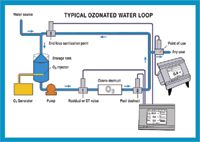
Figure 1: A typical ozonated water loop. For measuring dissolved ozone, the three key measurement points per distribution loop are residual, postdestruct, and return or end-loop values.
The residual value is the threshold dissolved ozone value based on the water system design. The purpose of this threshold is to ensure that no microbiological entity can survive ozone exposure anywhere in the affected system. Depending on several factors such as exposure time and other methods of microbiological control, the residual value will vary dramatically. The International Society for Pharmaceutical Engineering's (ISPE) baseline series guide on water and steam indicates it is common to operate a residual between a 0.02- and 0.2-mg/L (ppm) range (1). Experience shows more than 95% of all systems fall into this range, but it is also known that validated pharmaceutical water systems can operate well above 0.50 ppm (United States) and below 0.013 ppm (Europe) in storage tanks. European producers prefer lower values and US producers prefer higher values. This expanded range is still quite low compared with the values used in municipal and bottled-water treatment facilities where it is common for values to exceed 1 ppm.
After sanitization, the water must be distributed to the use points. The ozone must be removed from the water (i.e., at the destruct point). Ozone is very reactive and because most pharmaceutical products are susceptible to ozone attack, product quality may be affected. Destruct typically is accomplished with ultraviolet (UV) deactivation or degasification. Ozone is most often removed before the water is introduced into the distribution loop. Another method, gaining in popularity, is to remove the ozone at the POU. With either choice, the postdestruct water must be evaluated to assess whether the ozone has been removed completely. It is desired that the dissolved ozone value be zero or below detection limits, which range from 1–20 ppb depending on the instrument manufacturer.
The third key measurement point is the end-loop or return point. In a system that destructs the ozone before distribution, the value at this point typically is zero. During periods of loop sanitization, the destruct UV lamp is turned off, and ozonated water is allowed to circulate in the loop. Depending on the loop size, temperature, and water flow rate, the value at this point may be very close to the residual value or may be slightly below because of decay. The end-loop detector value must register a defined threshold value for a set period of time. This is the "loop disinfection time" or loop DT. On continuously ozonated loops, the POU sensor becomes this indicator. Once sanitization is complete, the UV light is turned back on, and the end loop value should be zero before water is usable again. Table I provides some typical values being turned on and off during various stages of the destruct.

Table I: Typical dO3 readings in ppm (mg/L).
POU monitoring is recommended by the ISPE (2). Primary among the good reasons to monitor POU is to ensure the measurement of potential dead legs, which are a key breeding area for microbial growth. Once biofilm gets a foothold in a water system, it is nearly impossible to remove (3). Even ozone's oxidizing power does not fully remove the biofilm labyrinth structure, thus making it easier for the next biofilm colony to form. The reasons not to measure at POU are usually financial because analyzers can be costly and many systems have numerous use points, some in the hundreds. In these cases, the entire POU system typically is validated on a yearly or a rotating sample point basis.
How are sensors installed?
More than 90% of instruments currently installed use electrochemical (EC)-style sensors, and therefore, this discussion will focus primarily on EC sensors. The others involved are primarily UV spectroscopic absorbtion-based, either measuring through the water matrix or by stripping the gas and measuring in the gas phase.
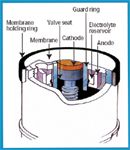
Figure 2: A polarographic cell diagram. In electrochemical sensors, the cell consists of two to three electrodes, a cathode, an anode, and possibly a guard-ring electrode.
In the spectroscopic analysis, 254-nm UV wavelength illuminates a volume of water or gas containing ozone through a fixed pathlength. The ozone absorbs some of the light intensity and, according to Beer's Law, the concentration of the absorbed light is directly proportional to the concentration of the analyte present (4). UV detectors are generally considered the best method for high-concentration gaseous measurement but not for dissolved measurement because of matrix interferences and stripping complexities.
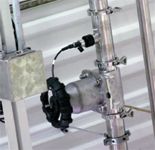
Figure 3: A straight T-connection can be welded to the pipe and the sensor can be inserted into the flowing sample stream.
EC sensors apply the polarographic principle of electrochemistry. The electrochemical cell consists of two or three electrodes, a cathode, an anode, and possibly a guard-ring electrode submersed in a electrolyte (see Figure 2). These parts are covered by a gas-permeable membrane. A specific potential is applied to the cathode that will selectively reduce the gas analyte of interest. Essentially, the membrane separates the gas from the liquid according to the principles of Henry's Law, which asserts that gases seek to be balanced across a permeable barrier (5). Because the cathode chemically changes the gas, the effective concentration in the electrolyte always remains zero, thus keeping a constant permeation of gas into the cell. The current generated by the reduction of ozone at the cathode is proportional to the concentration of the ozone outside the cell. Adjusting for temperature and solubility yields a dissolved value.

Figure 4: ProAcc valve for sampling DO3 in flowing liquid. Permits removal of sensor for service without disturbing the process.
EC sensors can be used either in-line or at-line. In-line analysis puts the sensor in direct contact with the bulk flow of the ozonated water (i.e., it is inserted directly into the pipe). A straight T-connection can be welded to the pipe, and the sensor can be inserted into the flowing sample stream (see Figure 3). This allows truly representative sampling. When the sensor must be removed, the whole system must be shut down unless valving with a bypass line is installed. Another way to achieve in-line analysis is to use a self-sealing valve (see Figures 4 and 5). These valves permit the sensor to be extricated by simply unscrewing the mounting collar which simultaneously closes the valve or by repositioning the ball valve. In both cases, the water system operation is unaffected by the ozone sensor removal. A minimum linear velocity (at least 20 cm/s) is required to operate an in-line sensor, so it is important to know the flow through the pipe before choosing this technique.
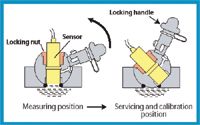
Figure 5: Ball valve access device for sampling DO in a pipe.
At-line analysis is typically conducted through a flow cell connected by 0.25-in. tubing coming off the main supply pipe (see Figure 6). The simplicity of installation and its low cost make this the most used method for measuring ozone in pharmaceutical plants. Flow rate required is manufacturer-dependent and varies from 100 mL/min to 1.5 L/min. Tubing runs between the main pipe and the flow cell should be as short as possible because long delays may result in ozone decomposition before analysis.
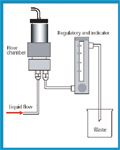
Figure 6: A typical flow chamber set-up. At-line analysis typically is conducted through a flow cell connected by 0.25-in. tubing coming off the main supply pipe.
What are some of the measurement challenges?
Outgassing of the dissolved ozone is one of the biggest problems that inhibit accurate pharmaceutical water sampling with instruments. EC-style sensors do not read mixed-phase samples (e.g., mixtures of gas and liquid) and only read in one phase at a time. In addition, ozone has a relatively low solubility in water (6). Henry's Law of partial pressures is a good model to follow when thinking about dissolved ozone. It states that the partial pressure of a gas above a liquid and the partial pressure of that gas dissolved in that liquid move towards equilibrium. If the ozone pressure above the liquid is lower than the ozone pressure in the liquid, then the ozone will migrate out of the liquid. Outgassing occurs when the process water experiences momentary hydrostatic pressure loss or cavitation. This can occur after a valve restriction, inside a pump, when flowing from a smaller to a larger diameter pipe, flowing down a vertical pipe, or on the suction side of a pump. This can also happen on the inside bend of a pipe, especially one of 90° or more. As the cavitations cease, the ozone typically redissolves in a pressurized pipe or vessel. This effect can cause confusion to the user especially if the verification sampling is done at a separate drop as opposed to sensor sampling. The values can be dramatically different.
Chemical interferences for EC sensors are few, most commonly from chlorine gas. When dealing with pharmaceutical waters, this interference is not much of an issue because chlorine should be removed. If it is present, chlorine will form the ionic version and not permeate through the membrane.
What are the calibration options?
Two methods of calibration are available to EC sensor users: titration and air calibration. As mentioned previously, no bottled ozone standard exists. Therefore, an indirect calibration method must be used.
Several titrants are available to measure dissolved ozone including sodium arsenite, potassium iodine, and N,N-diethyl-p-phenylenediamine. The International Ozone Association has recognized a colorimetric method using indigo trisulfonate (i.e., the indigo method) as the recommended standard for measuring dissolved ozone in water (7). The American Water Works Association has codified this method in their water analysis manual (8) as the established method for measuring dissolved ozone in a municipal water plant. This method also has been recognized as the standard method by the US Environmental Protection Agency. The indigo method is relatively easy to perform as long as one has access to a convenient laboratory space, some chemical agents, and a titration burette or a visible spectrophotometer.
With titration methods, the user must account for variability caused by sample temperature as well as the time decay (ozone half-life) and sampling methodology. The recommended sample temperature is 25 °C. Ozone half-life is ~20 min but varies with temperature, pH, water purity, and exposure to light. A proper zero must be established free of potential interferences, especially other oxidants such as chlorine. With careful attention to detail and a thermostated sample, one can achieve results in the range of ±10 ppb. This method is well documented (9).
Many users of pharmaceutical water system do not have convenient access to the water-testing laboratory. The laboratory may not be in the same building or even within walking distance. In these cases, the air calibration method is the best practice. Hale, who invented air calibration, discerned that oxygen could be measured with the same sensor used for ozone if the potential on the electrodes changed (10). The membrane-covered electrochemical sensor takes advantage of ozone's and oxygen's similar properties (e.g., molecular size and composition). Establishing the proper oxygen–ozone permeability ratio permits using a known oxygen concentration to establish an ozone-calibration curve with ±5 ppb absolute (0.005 mg/L) or ±5% of reading accuracy in the 0–50 °C range. Thus, air calibration is a more accurate standard than the titration methods.
An advantage of using air calibration is that no reagents are needed for calibration. Although air calibration is quick, readjustment of the sensor from measuring air to dissolved ozone may take several hours. Because of the readjustment time, it is often recommended that the air calibration be done primarily for the initial calibration and the sensor verified with a commercial kit after initial calibration.
How is the sensor verified?
One benefit of having both air calibration and titration available for dissolved ozone measurement is that if two differing technologies agree within the combined error margin, then it is more than coincidence. An air-calibrated sensor placed in line can be verified at defined intervals through titration.
The measurement of oxygen in the atmosphere is well understood (10) and by using a NIST-traceable barometer and thermometer, the transmitter automatically determines the oxygen content in the air. The air calibration can be considered traceable and is also a means to verify that the air calibration is functioning correctly.
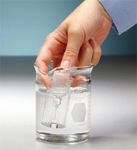
Figure 7: Ampule with dried reagent for quick check of DO3 (AccuVac, Hach Company, Loveland, CO).
Several commercially available kits have taken the laboratory-based indigo method and adapted it so that it can be used in a process environment (11). The kit incorporates a known amount of indigo titrant dried on the inside of a sealed and evacuated clear glass ampul. The ampul can then be placed in a flowing sample stream and cracked (see Figure 7). The water is sucked into the ampul by the vacuum, comes in contact with the indigo, and turns the water blue. The dissolved ozone consumes a portion of the indigo and lightens the color. The ampul can then be inserted into a spectrophotometer (see Figure 8) to quantify the color change. This kit has become the de facto standard for dissolved ozone analyzer verifications in the industry. Its accuracy is specified at ±0.01 mg/L (10 ppb). Of course, the same precautions taken with the indigo method should be observed here. Whether using the actual titration apparatus or the commercial kit, the analyzer value then is compared with value obtained from the indigo method. If it is within the combined margin of error (typically ±0.02 mg/L), then it is considered verified.
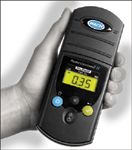
Figure 8: A pocket colorimeter.
How frequently should one calibrate and verify?
Calibration frequency is dependent on drift. Drift is a function of environmental and chemical conditions that include water temperature, hydrostatic pressure fluctuations, and dissolved ozone levels being measured. The use of the term, "drift," in this section cannot be confused with what instrument makers call "drift." Drift in instrument electronics is different than mechanical or wear-related drift. This article refers to "drift" that is a function of the water system's operating environment, not "drift" that is caused by inadequate shielding or inexpensive electronic components.
When dealing with temperature and dissolved gas analyzers, the rule of thumb is the cooler, the better. The higher the water temperature, the more frequent service and calibration will be needed. Ambient systems running in cool locations at or below 20 °C will have half the service requirements of an analyzer operating at or above 30 °C. This factor should be kept in mind when using a system that will be exposed to seasonal environmental conditions. Many technical support calls occur in the late summer months because concerned users go through the fall, winter, and spring without need to do maintenance and then the hot summer requires the sensor to be serviced twice in three months.
Pressure. The more often and more dramatic the pressure fluctuations seen by the sensor, the greater the likelihood of stressing the membrane and causing permeation changes that can cause drift. This more frequently affects the in-line units because they see the process conditions. Placing a sensor too near a pump or too close to valves that slam causes pressure spikes that affect service intervals. The at-line units do not experience process variations as much, but they can be affected by water-flow valves turning on and off. Going from 100 to 0 psig instantly will have a wearing affect on the membrane and may even tear it. Care should be taken in standard operating procedures to instruct the gradual reduction and resumption of flow to the sensor.
The final contributor to drift is the dissolved ozone level. Sensors exposed to the higher and constant residual typically have shorter service intervals than do the postdestruct and end-loop sensors. Ozone is a strong oxidant and the more the sensor is exposed, the greater the buildup of oxidation by-product coatings inside the sensor. Sensors used in end-loop and postdestruct applications can last as long as three years without needing maintenance, but a residual sensor seldom lasts more than a year.
Ultimately, the maintenance interval is dependent upon several variables, which cannot always be quantitatively assessed. The typical manufacturer recommendation is to service the sensor as needed. Because "as needed" is hard to schedule, experience over the years has shown pharmaceutical water system residual sensors should be verified at least monthly and maintained every 6–12 months. End-loop and postdestruct sensors should be maintained once per 12–24 months and verified at least quarterly as well. Verification may be more or less frequent depending on confidence and control limits.
Conclusion
Properties of dissolved gas ozone are unique and may be somewhat unfamiliar to pharmaceutical professionals who normally deal with temperature or liquid chemical sanitation methods. Ozone's powerful antimicrobial action must be balanced with a careful selection of dissolved ozone calibration and verification methods as well as sampling means and locations. Diagnosing system inconsistencies and approving sampling changes can be challenging if the basic principles are overlooked. In addition, a proper understanding of the accuracies and variability of calibration and verification methods and their appropriate use can lead to a good experience with dissolved ozone measuring analyzers.
Todd Blonshine is a senior scientist and global market manager at Hach Ultra Life Science Division, 102 Bonniewood Drive, Cary, NC 27511, tel. 919.387.5877, fax 919.387.5875, tblonshine@hachultra.com
References
1. International Society for Pharmaceutical Engineering (ISPE), Baseline Series, Vol. 4: Water and Steam Systems (ISPE, Tampa, FL, 2001), p. 105, section 8.3.4.
2. ISPE Baseline Series, Vol. 4: Water and Steam Systems (ISPE, Tampa, FL, 2001), p.123, section 8.8.4.
3. H. Traeger, "Microbial Control," Ultrapure Water, 22 (May/June), pp. 24–30 (2005).
4. D.A. Skoog and D.M. West, Principal of Instrumental Analysis (Saunders College/Holt, Rhinehart and Winston, Austin, TX, 2d ed., 1980), pp. 148–157.
5. Handbook of Chemistry and Physics (CRC Press, Boca Raton, FL, 50th ed., 1969), p. F-81.
6. L.F. Kosak-Channing and G.R. Helz "Solubility of Ozone in Aqueous Solutions of 0–0.6 M Ionic Strength at 5–30 °C," Environ. Sci. Technol. 17 (3), 145–149 (1983).
7. International Ozone Association (IOA), Standardization Committee Report: Colorimetric Method for Determination of Traces of Ozone in Water (IOA, Scottsdale, AZ, 1989).
8. American Water Works Association (AWWA), Standard Methods for the Examination of Water and Wastewater, "Method 4500-O3 B: Ozone Residual by Indigo Colorimetric Method" (AWWA, Denver, CO, 21st ed., 1993).
9. W.J. Masschelein et al., "Colorimetric Method for Manual Determination of Ozone Concentrations in Water," Ozone Science & Engineering, Special Issue on Quality Assurance in Ozone Practice (1998), pp. 443–445.
10. J.M. Hale et al., "Ozone Detection," Orbisphere Technical Note, No. 19 (2003).
11. AccuVac Ozone Analysis Kit (Hach Company, Loveland, CO).
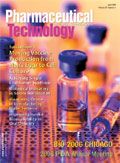
Entering New Domains for 3D Printing of Drug Products
April 6th 20253D printing of personalized medications is currently possible under existing compounding regulations, offering enhanced process control through automation. But new legislation coming in 2025 will allow 3D printing as part of a distributed manufacturing framework.